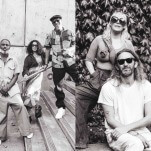Every Beer OEC Brews is Absolutely Bonkers
Photo via OEC Brewing
The quest for identity in today’s brewing industry is borderline Sisyphean. Customer demand dictates trends and, in a general sense, it falls on the brewery to either A) utilize a combination of marketing research and blind luck to predict where the arc will crest next, or B) capitalize on an existing trend before it gets played out; see the Samuel Adams portfolio circa 2015 to now for a prime example of the latter. And consumers, sooner or later, will sense whether or not a brewery is genuine in their pursuit, or looking for a quick cash grab. Cue neckbeard backlash.
OEC, aka Ordinem Eccentrici Coctores, aka “The Order of Eccentric Boilers,” decided to side-step this problem entirely, instead entering the market with a series of esoteric, blended sour projects. Their emergence was gradual, but not tentative; it was evident from the outset that head brewer Benjamin Neidhart had a clear vision for OEC, and that he has intention of narrowing that field of vision any time soon.
OEC operates, both figuratively and quite literally, within B. United Imports. Located in Oxford, Connecticut, about an hour’s train ride from Grand Central in New York City, B. United is my Disney World. The company, founded and operated by Ben’s father Matthias, imports shelf staples like Reissdorf Kolsch and the Schneider portfolio alongside less-renowned but still world-class producers like Switzerland’s BFM, the Belgian lambic blender Hanssen’s, Scotland’s Harviestoun, and others from Finland, England, South Africa, Italy, France, Japan, you name it.
Consider this: the simplest beer OEC brews, Exilis, is a 3.8% ABV Berliner-style weisse brewed using a three-part decoction mash, then fermented using a combination of spontaneous yeast drawn from the Connecticut country air in the brewery’s coolship, then re-pitched the following day with house yeast…which is itself a mutant grab-bag of cultures and wild bugs. Exilis, along with everything else coming out of OEC, is a stunning achievement that no one asked for. And though now OEC seemingly operates with nary a rough edge to sand down, the brewery’s ability to churn out consistently high-quality, complex beers is the result of careful, meticulous planning.
“The idea for the brewery had been gestating three years before it actually started,” head brewer Benjamin Neidhart tells me over the phone one morning. “It took a while to really put everything together, especially researching the brewhouse; we needed some special things. The brewhouse is actually a combination of copper and steel, and we had to find a supplier that could work with those materials. We also had to find someone who could construct a coolship, not something many suppliers could do. Kris from De Dolle helped a lot, as well as Professor Fritz Briem.”
It bears reiterating: OEC makes these kinds of beers exclusively. While other American breweries work with coolships, barrel-aging, and long fermentation, they tend to have the luxury of a quick-turnaround flagship product to subsidize the passion projects: Allagash White, Russian River IPAs, New Glarus Spotted Cow, etc. OEC, by comparison, is all passion project.
“We never really considered taking a more conventional approach,” Ben says. “I worked for a bit at [Bamberg-based smoked beer producer] Aecht Schlenkerla and [French Normandy cider-maker] Domaine Dupont. You spend nine years around a certain thing, and it can’t help but influence the way you operate.”
In reality, Ben has spent pretty much his entire life around products like this. As he points out, the fact that OEC is run quite literally under the same roof as B. United Imports, which his family owns, has a considerable impact not just on Ben’s vision for OEC, but on the way he executes that vision.
“We have a relationship with all these suppliers, and the last thing I want to do is copy. I love Old Engine Oil, but I’m not going to try and brew that here. The goal is to make something interesting; this is a shared infrastructure, we bottle at B. United. I don’t need a volume product.”
-

-

-

-

- Curated Home Page Articles By Test Admin October 21, 2025 | 3:10pm
-

- Curated Home Page Articles By Test Admin October 21, 2025 | 2:57pm
- Urls By Test Admin October 21, 2025 | 2:57pm
- Curated Home Page Articles By Test Admin October 21, 2025 | 2:55pm
-

-

-

-

-

-

-

-

-

-

-

-

-

-

-

-

-

-

-

-

-

-

-

-

-

-

-

-

-

-

-




































